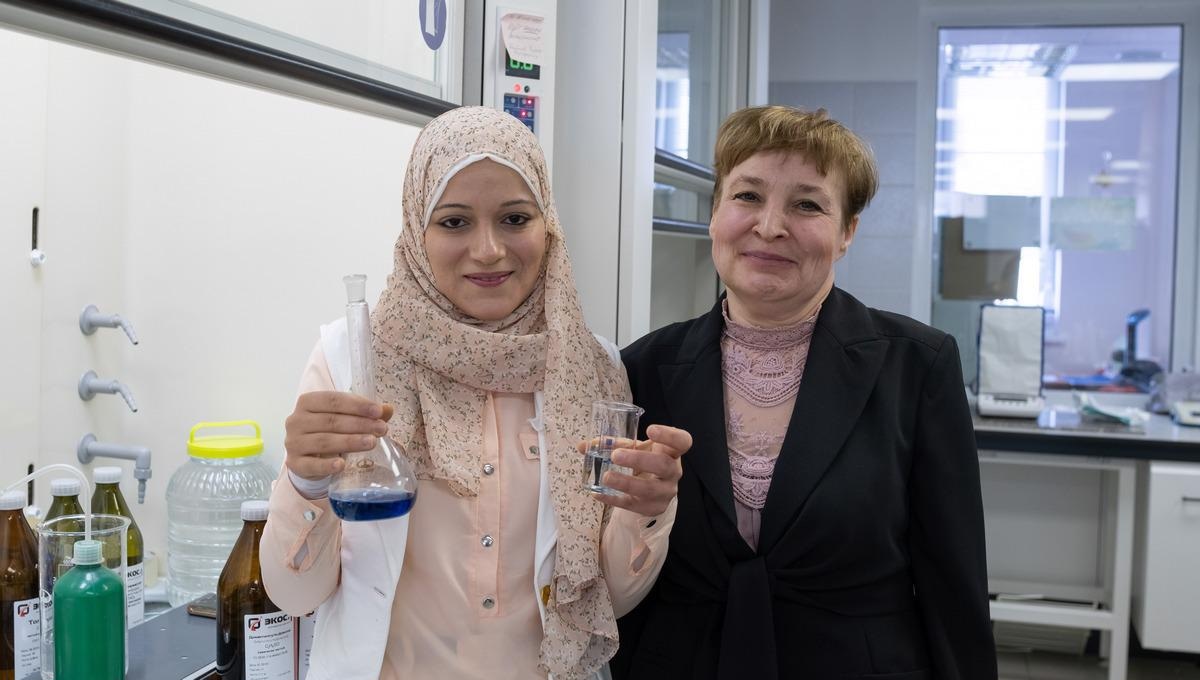A new sorbent with special abilities to remove heavy metals, like copper and zinc, from water solutions has been synthesized by a global research team headed by scientists at Ural Federal University.
 According to Asmaa Abu El-Soad and Elena Kovaleva, the sorbent purifies water in 40–60 minutes. Image Credit: Ilya Safarov.
According to Asmaa Abu El-Soad and Elena Kovaleva, the sorbent purifies water in 40–60 minutes. Image Credit: Ilya Safarov.
The resulting sorbent could be utilized for efficient treatment of heavy metal ions present in mine, industrial wastewater, ore water and drinking water. The results were published in the International Journal of Molecular Sciences.
The basis of the synthesized sorbent is chitosan, a natural biopolymer that is obtained by alkaline treatment of chitin, which is found in algae and yeast and is a major component of the cell walls of fungi, arthropod exoskeletons, and other invertebrates.
Elena Kovaleva, Research Group Head and Professor, Department of Technology of Organic Synthesis, Ural Federal University
“Chitin is one of the most abundant renewable materials on Earth. Studies conducted by me and my students in Rwanda showed that the most accessible source of chitin, in addition to expensive crustacean shells, are insect organisms, which can be bred specifically to produce chitin biomass,” adds Elena who is also a leading researcher in the UrFU Organic Synthesis Laboratory.
Because chitosan comprises amino and hydroxyl groups that effortlessly make complexes with metal ions, it has noticeable adsorption properties. By crosslinking chitosan with glutaraldehyde and epichlorohydrin, followed by the alteration with diethylentriamine and addition of monochloroacetic acid, chemists have enhanced the adsorption properties of chitosan.
In a series of experiments, we found that the most productive processes of adsorption of copper and zinc ions proceed at room temperature and the pH of aqueous solutions equal to 3.5. The maximum, 60%, adsorption of copper and zinc ions from aqueous solution occurred within 40 minutes in the first case and 60 minutes in the second.
Asmaa Abu El-Soad, Study Main Performer and Graduate Student, Department of Organic Synthesis Technology, Ural Federal University
Asmaa Abu El-Soad added, “Thus, our modified chitosan demonstrated better adsorption characteristics compared with such well-known sorbents as activated carbon, bentonite, shabasite, cellulose, rice husk, and others.”
By desorbing copper and zinc ions, the research team, comprising researchers from Egypt, Italy, Saudi Arabia, and Jordan along with the UrFU staff, regenerated the altered sorbent at the second stage of the study. Eventually, researchers identified that the removal of the huge amount of copper ions from chitosan is provided by solutions with particular nitric acid concentrations. A similar effect is produced by urea in the case of zinc ions.
In other words, the sorbent we obtained is reusable. The copper and zinc extracted as a result of the adsorption and desorption cycle will return to industrial production. Thus, the technology of cleaning industrial wastewater, as well as drinking water with our sorbent will be environmentally friendly and cost-effective.
Elena Kovaleva, Research Group Head and Professor, Department of Technology of Organic Synthesis, Ural Federal University
The study was financially supported by the Russian Foundation for Basic Research through a grant.
Journal Reference:
El-Soad, A. M. A., et al. (2022) Chitosan Functionalized with Carboxyl Groups as a Recyclable Biomaterial for the Adsorption of Cu (II) and Zn (II) Ions in Aqueous Media. International Journal of Molecular Sciences. doi.org/10.3390/ijms23042396.